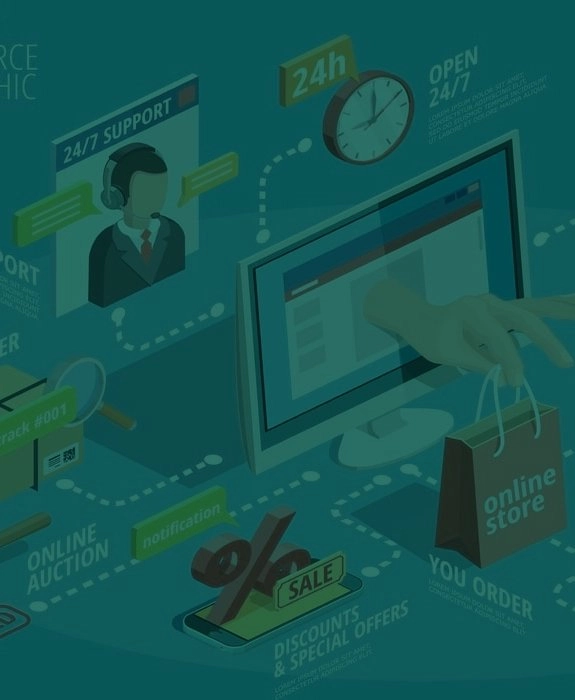Table of Contents
Through e-commerce, retail businesses have acquired substantial users over the years, and this number is only going to exponentially grow in due course of time. Keeping up with the latest developments in e-commerce is vital to creating cutting-edge competitiveness in the retail space.
Social commerce(Scom) will become the norm
30% of online shoppers say they would likely purchase the same products through social media.23.7% of internet users claim they discover new brands and products on social media through recommendations or comments. S-Com enables consumers to buy products from a third-party company, and businesses in turn can benefit from S-Com in a variety of ways:
- Build trust and brand loyalty.
- Enable frictionless checkout
- Boost sales through mobile shoppers
- Consistently get good customer traffic
Use these S-Com tools to amplify your business’ social media presence.
- Facebook shop page – Facebook brings about 85% of all social media orders.
- Instagram shoppable posts– add product tags to the Instagram posts, enabling users to make immediate purchases when clicked.
- Pinterest product pins– Pinterest eases the shopping experience through marketing pins.
Use of Artificial Intelligence (AI) will surge
AI has become a powerful tool in understanding consumer choices and browsing habits. Let us discuss the crucial benefits of AI for your online business.
- 88.05% of online shopping orders were abandoned, as per a 2020 report by Statista.Use conversational AI to create a “salesperson” effect to the e-commerce experience.
- As per a study by Gartner, “Smart personalization engines used to recognize customer intent will enable digital businesses to increase their profits by up to 15%.” Provide personalized shopping experience using Big data, which will improve sales and customer retention.
- According to repricerexpress, “70% of shoppers would shop for an item at a competitor if it was unavailable, rather than waiting any length of time for back-ordered inventory.” Manage your inventory with AI through predictive analytics, trend forecasting, and data mining.
- According to conversight.ai, “By 2019, half of the major commerce companies and retailers with online stores will have redesigned their commerce sites to accommodate voice searches and voice navigation.” Use schema markups, optimize for natural language processing, focus on product tagging and categorizing when considering AI for voice commerce.
Augmented Reality (AR) will amplify customer experience
AR is a trailblazing immersive technology that is rapidly finding applications in product-driven industries. According to Statista, the market for AR technology is growing, with projections for 2023 valuing it at over $18 billion U.S. dollars. It also predicts that consumer spending on standalone and embedded augmented reality mobile applications worldwide will reach $15.497 million by 2022.
The following benefits of AR have made it a sought after technology in 2021.
- Enable your customers to make informed buying choices. 61% of online shoppers prefer to make purchases on sites that offer AR technology.
- 63% of customers say AR would transform their shopping experience. Boost user experience and user engagement through AR.
- AR is picking up steam in eCommerce. Boost your brand image and loyalty by being one of the forerunners to offer the AR experience. 70% of consumers are expected to be more loyal to brands incorporating AR as part of their shopping experience.
Your e-commerce business can use AR in the following ways.
- Virtual wear-on solution – Promote sales and eliminate product returns from unsatisfied customers. Create an immersive shopping experience using extended face tracking (for fashion and beauty apps), gaze tracking and face-based AR (for facial recognition apps).
- Preview product placement – Guide buyers to choose the right décor to fit their environment using 3-D object detention.
- Interactive user guides – Automate customer support through interactive user manuals. Create a real-life environment by just scanning the manual using a mobile.
- Virtual fitting room – Nearly 77% of online shoppers say they returned their products solely because of poor fitting. Further, 58% of shoppers say they would buy more clothes online if they are assured of the accurate body fitting. Reduce product returns and increase business profits using virtual rooms.
Influencer Marketing (IM) will gain prominence
89% of marketers say ROI from influencer marketing is comparable to or better than other marketing channels. IM generates sales leads, improves brand awareness, build brand credibility, and boosts your brand’s SEO.
Use these crucial steps to build your brand’s IM strategy.
- Define the campaign goals.
- Choose influencer engagement blueprint: influencers share your content in their own or pay them for your brand promotion. You can also use a combination of both.
- Create a buyer persona.
- Identify an influencer who best suits your campaign.
- Qualify your influencers and check whether they have the audience your brand requires.
- Create the right content.
- Track and analyze the campaign outcome.
Green consumerism will impact customer choices
Consumers are more inclined towards eco-friendly products and brands practicing environmental sustainability.
Keep these pointers in mind to create a “green e-commerce” business:
- Use recycled and recyclable materials in packing.
- Join hands with delivery partners who have green credentials.
- Maintain your business’ carbon footprint.
- Partner with green advocacy groups to launch sustainable consumption campaigns.
Analytics-driven personalisation will influence sales
86% of consumers say personalization plays an important role in their buying decisions. 87% of shoppers said they buy more when online stores personalize the shopping experience. Personalization opens up new frontiers in data-driven marketing, enabling increased user engagement, deeper loyalty, and a measurable ROI.
Using Big data analysis will augment your business performance in the following ways:
- Improve shopper analysis
- Elevate user experience
- Provide more secure payment options
- Optimize pricing and increase sales
- Predict trends and demands
Conclusion
Customers engage and interact with brands that are innovative and keep up with the changing customer needs. E-commerce businesses should adopt the latest trends in their sector to survive the aggressive competition.
Stay ahead of the game with our helpful resources

4 digital solutions to address common application performance issues
High network latency, memory leaks, slow page loads, heavy CPU usage, and unresponsive servers are all typical performance issues we’ve experienced at some point when using or accessing digital applications. With how easy they occur in projects across verticals, you might be wondering whether the development teams behind these programs have done enough due diligence prior to the release. But human errors and oversight aren’t always the culprit. The reality is that while developers can strive to develop a fully functioning program with virtually no apparent faults upon delivery, no software is truly error-free. Even the most rigorously tested applications

6 useful tips for creating more robust application lifecycle management
As digital technology becomes the norm, software acquisition is now key to gaining a competitive edge in today’s market. Be it as a value offering tailored to consumers or a productivity tool to run complex processes, custom software undeniably helps companies drive growth and deliver value more efficiently. Just as necessary as having a proprietary application is prescribing a standard procedure to govern and maintain its utility. This is to ensure that your business can develop or adopt the right type of software—one that can fully cater to your business needs while keeping disruption to a minimum across critical milestones.

5 major roadblocks businesses must overcome when transitioning into a new software environment
As the business landscape becomes increasingly saturated, staying ahead of the curve often means embracing disruptive technologies to meet the fickle market demands. In most cases, this entails knowing when to pivot your current strategy to an entirely new solution. But recognizing the importance of digital shift is one thing; implementing the necessary IT upgrade is another. A global survey by Deloitte has found that although 87% of companies manage to identify the impact of digital trends on their industries, only 44% have adequately prepared for the coming disruptions. This vast disconnect between organizational expectations and conditions in the field

Is cloud computing the answer to better software development?
Cloud computing is perhaps not a term often heard in daily conversations, but it is one with a far-reaching impact on our technological needs. From expansive options of online data storage to numerous suites of web-based productivity tools like Google Workspace, nearly everyone has used a cloud-enabled technology. Over the last decade, this high degree of versatility also underpins the rapid cloud uptake among businesses. In fact, one survey has found that 94% of companies have already shifted their computing workloads on cloud platforms to varying extents. Unsurprisingly, the market size for cloud technology continues to grow exponentially. With a



